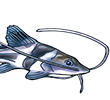L-351 Panaque/Panaqolus
- Shane
- Expert
- Posts: 4639
- Joined: 30 Dec 2002, 22:12
- My articles: 69
- My images: 162
- My catfish: 75
- My cats species list: 4 (i:0, k:0)
- My aquaria list: 4 (i:4)
- Spotted: 99
- Location 1: Tysons
- Location 2: Virginia
- Contact:
These should get you started. A simple search of the forum will turn up more information.
http://www.forum.planetcatfish.com/viewtopic.php?t=4396
http://www.forum.planetcatfish.com/viewtopic.php?t=2502
http://www.forum.planetcatfish.com/viewtopic.php?t=3962
-Shane
http://www.forum.planetcatfish.com/viewtopic.php?t=4396
http://www.forum.planetcatfish.com/viewtopic.php?t=2502
http://www.forum.planetcatfish.com/viewtopic.php?t=3962
-Shane
"My journey is at an end and the tale is told. The reader who has followed so faithfully and so far, they have the right to ask, what do I bring back? It can be summed up in three words. Concentrate upon Uganda."
Winston Churchill, My African Journey
Winston Churchill, My African Journey
- Erwin
- Posts: 184
- Joined: 08 Oct 2003, 14:37
- My articles: 1
- My images: 5
- Spotted: 6
- Location 1: Augsburg, Germany
- Interests: esp. cichlids, catfish
- Contact:
- Caol_ila
- Posts: 1281
- Joined: 02 Jan 2003, 12:09
- My images: 52
- Spotted: 23
- Location 1: Mainz, Germany
hi!
Absolutely great pleco. hes into wood, veggies and larvaes, daphnia, gammarus also. So pretty easy to feed. Hes also very active.
I bought him 12 cm long and he hasnt grown much since.
Heres a pic of the mouth

heres the fish


from what i can tell it would take years till this fish gets to 40-50 cm...
Absolutely great pleco. hes into wood, veggies and larvaes, daphnia, gammarus also. So pretty easy to feed. Hes also very active.
I bought him 12 cm long and he hasnt grown much since.
Heres a pic of the mouth
heres the fish
from what i can tell it would take years till this fish gets to 40-50 cm...
cheers
Christian
Christian
- Erwin
- Posts: 184
- Joined: 08 Oct 2003, 14:37
- My articles: 1
- My images: 5
- Spotted: 6
- Location 1: Augsburg, Germany
- Interests: esp. cichlids, catfish
- Contact:
I don't think the L351 (L186a) is the one which gets so big, because I have seen them with about 15 cm, already with greatly enlarged odontodes on the sides. Werner and the Japanese pages reffer to the other one (L350) for reaching this size. A strange species, rather difficult to place to any of the described genera.
Erwin
Erwin
Thanks to the experts for the informative replies.
What would be a reasonable maximum size estimate for the L-351 in the aquarium, if it doesn't grow as big as the L-350? Erwin, at 15cm, does the L-351 still retain its leopard pattern or does it become black all throughout?
Peru has some distinctive panaques. Japanese sites list a Peru green panaque
http://pictures.care2.com/view/2/389062359
http://pictures.care2.com/view/2/419132800
Aqualog has also listed an LDA29 "red brown panaque" that I haven't seen for sale in any German or Japanese site. Is this a rare fish?
What would be a reasonable maximum size estimate for the L-351 in the aquarium, if it doesn't grow as big as the L-350? Erwin, at 15cm, does the L-351 still retain its leopard pattern or does it become black all throughout?
Peru has some distinctive panaques. Japanese sites list a Peru green panaque
http://pictures.care2.com/view/2/389062359
http://pictures.care2.com/view/2/419132800
Aqualog has also listed an LDA29 "red brown panaque" that I haven't seen for sale in any German or Japanese site. Is this a rare fish?
- Erwin
- Posts: 184
- Joined: 08 Oct 2003, 14:37
- My articles: 1
- My images: 5
- Spotted: 6
- Location 1: Augsburg, Germany
- Interests: esp. cichlids, catfish
- Contact:
The fish on the following picture:

is probably a male with about 13.5 cm standardlength (SL) [see arrows from where to where SL is meassured]. And you probably can notice that is has enlarged odontodes on the sides, especially around the caudal peduncle, but also the interoperuclar odontodes are enlarged. It has lost its filaments on the caudal fin (through catch or transport(?)).
At the moment its best placed within Panaqolus, but maybe it also belongs to a yet undescribed genus of wood eating catfishs.
Erwin

is probably a male with about 13.5 cm standardlength (SL) [see arrows from where to where SL is meassured]. And you probably can notice that is has enlarged odontodes on the sides, especially around the caudal peduncle, but also the interoperuclar odontodes are enlarged. It has lost its filaments on the caudal fin (through catch or transport(?)).
At the moment its best placed within Panaqolus, but maybe it also belongs to a yet undescribed genus of wood eating catfishs.
Erwin
- Erwin
- Posts: 184
- Joined: 08 Oct 2003, 14:37
- My articles: 1
- My images: 5
- Spotted: 6
- Location 1: Augsburg, Germany
- Interests: esp. cichlids, catfish
- Contact:
I am not 100% sure, but mostly when they show these secondary sexual dimorphisms, they have reached an adult size and won't grow much anymore. But on the other hand I have read that (some?) fish can grow as long as they live, probably slowly but still. The biggest L351 which I have seen so far, was about 15 cm SL.
Erwin
Erwin




